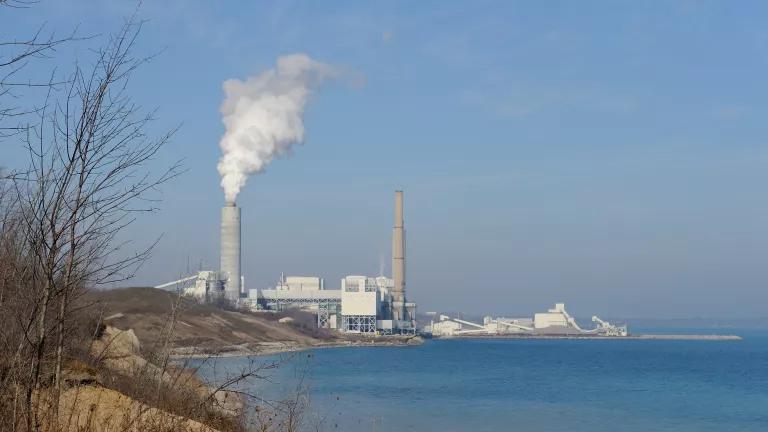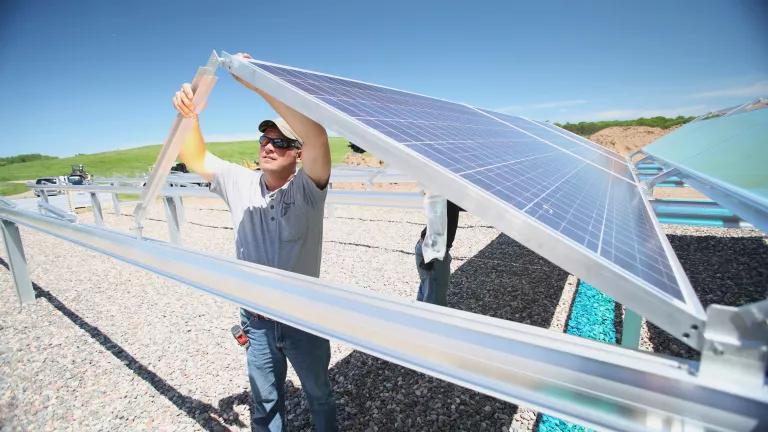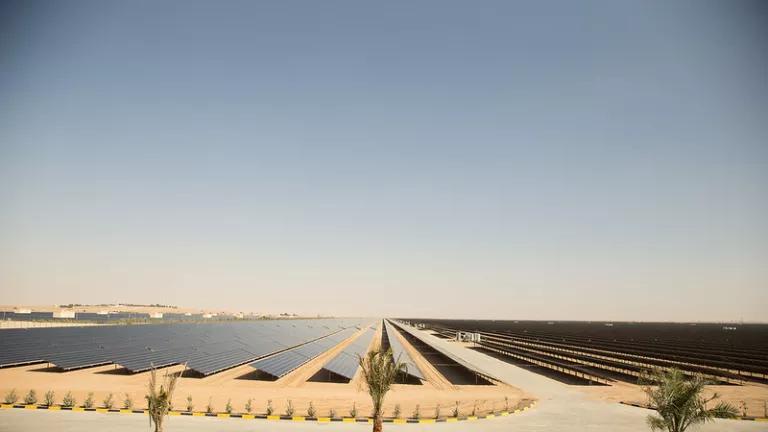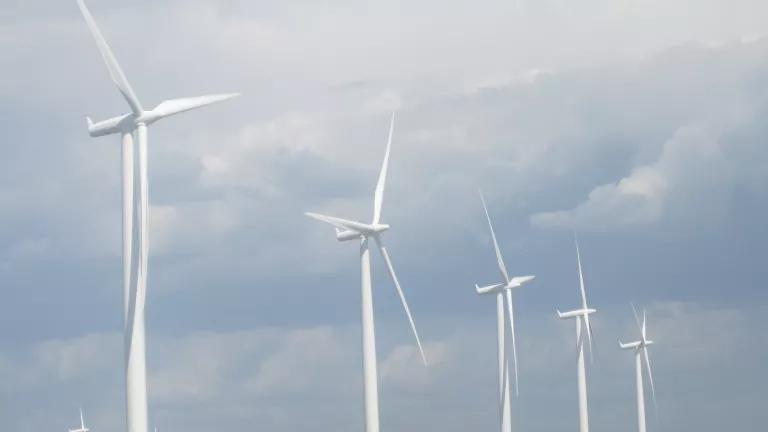A Tale of Two Capacity Auctions—and Still Too Much Coal
A capacity price spike impacted Illinoisans’ electricity bills last June. How have things changed? It’s a mixed bag—with too many fossil fuels inside.

We Energies' Oak Creek coal plant located south of Milwaukee on Lake Michigan. The coal plant's closure date was pushed back after MISO's 2022 capacity auction.
JanetandPhil via Flickr, CC BY-NC-ND 2.0.
Every year, MISO, the grid operator for much of the middle of the country, holds an auction to make sure it has adequate resources to meet peak demand in its territory. Last April, MISO announced a power supply shortfall. This meant two things: a slightly increased risk of power outages, and soaring prices for the capacity market. As a result, electricity costs for Ameren Illinois ratepayers in Central and Southern Illinois more than doubled in June 2022.
MISO and its Market Monitor had long warned of capacity constraints, and last year’s increased risk of blackouts was a disaster years in the making. Some grid operators blamed coal plant retirements, pointed to state policy changes like Illinois’ nation-leading Climate and Equitable Jobs Act, and promoted fossil fuels as a reliability solution. Clean energy advocates and legislators pushed back, saying it is MISO’s job to anticipate planned coal plant closures and proactively implement grid solutions that would have better enabled clean energy to quickly fill the gap.
MISO has recently taken some long overdue and much-needed steps to bolster the grid. Last July, 11 years after its last large portfolio of transmission lines was approved, MISO approved the largest investment in transmission in U.S. history. However, the lines won’t be built until 2030—much too late for the Illinoisans on the hook for $52 more a month in electricity costs this past year. MISO’s foot dragging on grid solutions left us a decade behind and much more vulnerable to the volatility and uncertainty of price swings and outages.
So, what happened this year? This May, MISO’s planning resource auction found a surplus of electricity generators. Capacity prices heading into June 2023 plummeted over 93 percent. While this is great news for electricity bills and grid reliability, MISO still has a long way to go to prevent us from yo-yoing prices—and from relying too heavily on fossil fuels that don’t always show up when they’re needed most. The grid operator acknowledged that the factors that helped this year’s auction results—including delayed coal plant retirements—may not be repeatable.
Ultimately, the root of the problem remains unsolved: Our transmission system is lagging behind the reality of our clean energy transition. If grid operators fail to swiftly accommodate the influx of clean energy resources as retirements of costly coal and gas plants are supposed to accelerate, the Midwest could miss out on clean air, clean jobs, and cheaper power and instead remain stuck with polluting fossil fuel power in a climate crisis. Now is the time for MISO to double down on solving our grid’s long-term problems with forward-looking clean energy and transmission solutions.
Let’s do more of what works: Clean energy and a stronger transmission system
The MISO region met its capacity and reserve requirements this year in part due to nearly 3.6 Gigawatts (GW) of coal power postponing retirements. But we know coal is a disaster for public health and climate, we know it’s uneconomic, and we know it can fail during extreme weather. And, 2.3 GW of polluting coal plants still powered down and left the grid. Those 3.6 GW of coal aren’t going to be around much longer—and that’s a good thing.
In better news, wind, solar, and demand response added 4.6 GW of installed capacity to the grid since the last capacity auction. And there’s more where that came from: Nearly 34 GW of proposed wind, solar, storage and hybrid projects in Illinois alone are waiting in the MISO interconnection queue for approval to get built. It’s important that MISO eliminates the backlog to study these clean energy projects and fast-tracks transmission planning efforts to accommodate the levels of clean energy resources needed to replace outgoing fossil fuels.
Let’s do less of what doesn’t really work: Fossil fuels
Let’s face it: fossil fuels are not the capacity champions we need, especially in a changing climate with more extreme weather (caused by burning fossil fuels).
Time and time again, wind and solar resources outperformed natural gas and coal when it counted most. That was the case during past crippling weather events including the 2011 cold weather outages in the Southwest, the 2014 polar vortex, 2021’s Winter Storm Uri, and most recently, Winter Storm Elliott. In fact, a whopping 22 GW of coal power—6 times the coal capacity that delayed retirement this year, and 40 percent of MISO grid’s coal fleet—was offline during Elliott. The pattern is clear: fossil fuel plant outages threatened the grid’s stability while renewable resources delivered.
In the face of looming capacity shortfalls and potential outages, MISO should not count on fossil fuels that undermine the power system. Rather than relying on the whims of aging coal plants delaying retirement, MISO must forge ahead with more transmission to enable more clean energy and energy storage capacity.
The grid needs an overhaul for our new clean energy and climate reality
Our antiquated, status quo grid cannot get us through the unprecedented changes we’re seeing: rising electricity demand, a shift from fossil fuel power plants to clean energy, and more frequent extreme weather events. A modern, better integrated grid that is bigger than the weather systems can.
During Elliott, energy was shipped into MISO and out the other side to keep lights on for MISO’s neighbors, yet grid constraints led to wasted wind power while rolling blackouts occurred elsewhere. Meanwhile, 78 percent of electricity generation sidelined during the storm were coal or gas plants. As fossil fuels struggled, wind and demand response showed up. Grid improvements that can add new clean energy capacity to the grid and make existing renewable energy more available are critical for reliability. Building the clean energy grid we need to weather stronger storms will also save money compared to relying on expensive, outage-prone fossil fuels—it’s why MISO found that investing $10.3 billion in reliability improvements will actually yield $37 billion in ratepayer benefits. The most effective way to protect the grid against extreme weather is also the most economic.
It will take a collaborative effort to transform the grid into a system capable of integrating the tsunami of renewable power that’s coming and capable of withstanding more frequent extreme weather events, with MISO playing a leading role. Now is the time for more vision and leadership to implement a rapid transformation of our energy infrastructure and facilitate the level of clean energy needed to deliver the benefits of fossil fuel free power.
To help get much-needed capacity online quickly, MISO must recognize the value of clean resources and design a grid that can better utilize these energy resources—and better share them across regions. We need a bigger, stronger, more resilient grid with much more transmission capacity that can allow an abundance of wind, solar, and energy storage to power our homes. And we need MISO to make it happen.



